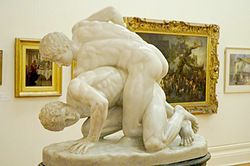Uffizi

The Uffizi Gallery (UK: ; Italian: Galleria degli Uffizi, pronounced [ɡalleˈriːa deʎʎ ufˈfittsi]) is a prominent art museum located adjacent to the Piazza della Signoria in the Historic Centre of Florence in the region of Tuscany, Italy. One of the most important Italian museums and the most visited, it is also one of the largest and best known in the world and holds a collection of priceless works, particularly from the period of the Italian Renaissance. After the ruling House of Medici died out, their art collections were given to the city of Florence under the famous Patto di famiglia negotiated by Anna Maria Luisa, the last Medici heiress. The Uffizi is one of the first modern museums. The gallery had been open to visitors by request since the sixteenth century, and in 1765 it was officially opened to the public, formally becoming a museum in 1865.
Excerpt from the Wikipedia article Uffizi (License: CC BY-SA 3.0, Authors, Images).Uffizi
Piazzale degli Uffizi, Florence Quartiere 1
Geographical coordinates (GPS) Address Phone number Website External links Nearby Places Show on map
Geographical coordinates (GPS)
| Latitude | Longitude |
|---|---|
| N 43.768333333333 ° | E 11.255277777778 ° |
Address
Galleria degli Uffizi
Piazzale degli Uffizi 6
50122 Florence, Quartiere 1
Tuscany, Italy
Open on Google Maps










